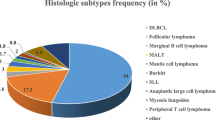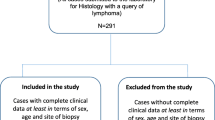Abstract
Several reports have shown a different distribution of malignant lymphoma (ML) in Asian and Western populations. The purpose of our survey was to elucidate whether there are substantial differences in the frequencies of subtypes of ML between different geographical areas. All entities diagnosed as ML between June 1995 and December 2007 were selected according to the 2008 World Health Organization (WHO) classification and searched for clinical outcomes. The cases were retrieved and reviewed by a panel of clinical haematologists and haematopathologists. A total of 303 patients with ML were identified for retrospective analysis. Of the 303 patients with ML, 278 patients (91.7%) had non-Hodgkin’s lymphoma (NHL), and 25 (9.2%) had Hodgkin’s lymphoma. Of the 278 patients with NHL, 223 (73.6%) had lymphoma of B-cell lineage, and 55 (18.1%) had lymphoma of T-cell lineage. One hundred and thirty-seven patients were diagnosed with diffuse large B-cell lymphoma, which was the most common B-cell lineage subtype and accounted for 45.2% of patients with NHL. Peripheral T-cell lymphomas were the most frequent subset of the T-cell neoplasms, comprising 10.6% of ML. Extranodal involvement was found in 125 (44.9%) of the 278 patients with NHL, and the lymph node was the site of primary involvement in 153 patients (55.1%). Fifty-nine (47.2%) of the 125 patients with extranodal presentation had gastrointestinal tract involvement. Outcome was worse in patients with extranodal NHL than in those with nodal NHL through the entire follow-up period; the difference in survival rates was significant. Our findings clarify the applicability and prognostic relevance of the WHO classification system and provide further information about the incidence of various lymphoma subtypes in Taiwan. Primary extranodal NHL was associated with a worse prognosis and distinct characteristics compared with nodal NHL. The outcome of different types of extranodal NHL should be investigated further.





Similar content being viewed by others
References
Swerdlow SH, Campo E, Harris NL, Jaffe ES, Pileri SA, Stein H et al (2008) WHO classification of tumours of haematopoietic and lymphoid tissues, 4th edn. International Agency for Research on Cancer, Lyon
Harris NL, Jaffe ES, Diebold J, Flandrin G, Muller-Hermelink HK, Vardiman J (2000) Lymphoma classification—from controversy to consensus: the R.E.A.L. and WHO classification of lymphoid neoplasms. Ann Oncol 11:3–10
Jaffe ES, Harris NL, Stein H, Vardiman JW (2001) Tumours of hematopoietic and lymphoid tissues. LARC, Lyon
The International Non-Hodgkin's Lymphoma Prognostic Factors Project (1993) A predictive model for aggressive non-Hodgkin's lymphoma. N Engl J Med 329:987–994
Naresh KN, Srinivas V, Soman CS (2000) Distribution of various subtypes of non-Hodgkin's lymphoma in India: a study of 2773 lymphomas using R.E.A.L. and WHO classifications. Ann Oncol 11:63–67
Han X, Kilfoy B, Zheng T, Holford TR, Zhu C, Zhu Y et al (2008) Lymphoma survival patterns by WHO subtype in the United States, 1973–2003. Cancer Causes Control 19:841–858
Xiao C, Su ZL, Wu QL, Gao HY, Fang JC, Xia ZJ et al (2005) Clinical and pathological reassessment of 493 cases of non-Hodgkin's lymphomas according to current WHO classification of lymphoid neoplasms. Zhonghua Bing Li Xue Za Zhi 34:22–27
Shivarov V, Dimitrov J, Guenova M (2005) Lymphoid neoplasms in Bulgaria according to the WHO classification (2001). The experience of the National Center of Haematology. Haematologica 90:ELT07
Economopoulos T, Papageorgiou S, Dimopoulos MA, Pavlidis N, Tsatalas C, Symeonidis A et al (2005) Non-Hodgkin's lymphomas in Greece according to the WHO classification of lymphoid neoplasms. A retrospective analysis of 810 cases. Acta Haematol 113:97–103
Isikdogan A, Ayyildiz O, Buyukcelik A, Arslan A, Tiftik N, Buyukbayram H et al (2004) Non-Hodgkin's lymphoma in southeast Turkey: clinicopathologic features of 490 cases. Ann Hematol 83:265–269
Lee SS, Cho KJ, Kim CW, Kang YK (1999) Clinicopathological analysis of 501 non-Hodgkin's lymphomas in Korea according to the revised European-American classification of lymphoid neoplasms. Histopathology 35:345–354
Lymphoma Study Group of Japanese Pathologists (2000) The world health organization classification of malignant lymphomas in Japan: incidence of recently recognized entities. Pathol Int 50:696–702
Sukpanichnant S (2004) Analysis of 1983 cases of malignant lymphoma in Thailand according to the World Health Organization classification. Hum Pathol 35:224–230
Lee MY, Tan TD, Feng AC, Liu MC (2006) Clinicopathological analysis of 598 malignant lymphomas in Taiwan: seven-year experience in a single institution. Am J Hematol 81:568–575
Chang KC, Huang GC, Jones D, Tsao CJ, Lee JY, Su IJ (2004) Distribution and prognosis of WHO lymphoma subtypes in Taiwan reveals a low incidence of germinal-center derived tumors. Leuk Lymphoma 45:1375–1384
Jaffe ES, Chan JK, Su IJ, Frizzera G, Mori S, Feller AC et al (1996) Report on the workshop on nasal and related extranodal angiocentric T/natural killer cell lymphomas. Am J Surg Pathol 20:103–111
Chuang SS, Lin CN, Li CY (2000) Malignant lymphoma in southern Taiwan according to the revised European–American classification of lymphoid neoplasms. Cancer 89:1586–1592
Ho FC, Todd D, Loke SL, Ng RP, Khoo RK (1984) Clinico-pathological features of malignant lymphomas in 294 Hong Kong Chinese patients, retrospective study covering an eight-year period. Int J Cancer 34:143–148
Kadin ME, Berard CW, Nanba K, Wakasa H (1983) Lymphoproliferative diseases in Japan and Western countries: proceedings of the United States–Japan Seminar, September 6 and 7, 1982, in Seattle, Washington. Hum Pathol 14:745–772
Freeman C, Berg JW, Cutler SJ (1972) Occurrence and prognosis of extranodal lymphomas. Cancer 29:252–260
Otter R, Gerrits WB, vd Sandt MM, Hermans J, Willemze R (1989) Primary extranodal and nodal non-Hodgkin's lymphoma. A survey of a population-based registry. Eur J Cancer Clin Oncol 25:1203–1210
d'Amore F, Christensen BE, Brincker H, Pedersen NT, Thorling K, Hastrup J et al (1991) Clinicopathological features and prognostic factors in extranodal non-Hodgkin lymphomas. Danish LYFO Study Group. Eur J Cancer 27:1201–1208
Zucca E, Roggero E, Bertoni F, Cavalli F (1997) Primary extranodal non-Hodgkin's lymphomas. Part 1: gastrointestinal, cutaneous and genitourinary lymphomas. Ann Oncol 8:727–737
Teh BH, Lin JT, Pan WH, Lin SH, Wang LY, Lee TK et al (1994) Seroprevalence and associated risk factors of Helicobacter pylori infection in Taiwan. Anticancer Res 14:1389–1392
Mitchell HM, Li YY, Hu PJ, Liu Q, Chen M, Du GG et al (1992) Epidemiology of Helicobacter pylori in Southern China: identification of early childhood as the critical period for acquisition. J Infect Dis 166:49–53
Rocha GA, Oliveira AMR, Quieroz DM, Moura SB, Mendes EN (1994) Prevalence of Helicobacter pylori infection in two different populations from Minas Gerais, Brazil. Am J Gastroenterol 89:1313
Katelaris PH, Tippett GH, Norbu P, Lowe DG, Brennan R, Farthing MJ (1992) Dyspepsia, Helicobacter pylori, and peptic ulcer in a randomly selected population in India. Gut 33:1462–1466
Bardhan PK (1997) Epidemiological features of Helicobacter pylori infection in developing countries. Clin Infect Dis 25:973–978
Al-Moagel MA, Evans DG, Abdulghani ME, Adam E, Evans DJ Jr, Malaty HM et al (1990) Prevalence of Helicobacter (formerly Campylobacter) pylori infection in Saudia Arabia, and comparison of those with and without upper gastrointestinal symptoms. Am J Gastroenterol 85:944–948
The Non-Hodgkin's Lymphoma Classification Project (1997) A clinical evaluation of the international lymphoma study group classification of non-Hodgkin's lymphoma. Blood 89:3909–3918
Arcaini L, Burcheri S, Rossi A, Passamonti F, Paulli M, Boveri E et al (2006) Nongastric marginal-zone B-cell MALT lymphoma: prognostic value of disease dissemination. Oncologist 11:285–291
Thieblemont C, Bastion Y, Berger F, Rieux C, Salles G, Dumontet C et al (1997) Mucosa-associated lymphoid tissue gastrointestinal and nongastrointestinal lymphoma behavior: analysis of 108 patients. J Clin Oncol 15:1624–1630
Thieblemont C, Berger F, Dumontet C, Moullet I, Bouafia F, Felman P et al (2000) Mucosa-associated lymphoid tissue lymphoma is a disseminated disease in one third of 158 patients analyzed. Blood 95:802–806
Raderer M, Wöhrer S, Streubel B, Troch M, Turetschek K, Jäger U et al (2006) Assessment of disease dissemination in gastric compared with extragastric mucosa-associated lymphoid tissue lymphoma using extensive staging: a single-center experience. J Clin Oncol 24:3136–3141
Raderer M, Vorbeck F, Formanek M, Osterreicher C, Valencak J, Penz M et al (2000) Importance of extensive staging in patients with mucosa-associated lymphoid tissue (MALT)-type lymphoma. Br J Cancer 83:454–457
Nathwani BN, Anderson JR, Armitage JO, Cavalli F, Diebold J, Drachenberg MR et al (1999) Marginal zone B-cell lymphoma: a clinical comparison of nodal and mucosa-associated lymphoid tissue types. Non-Hodgkin's Lymphoma Classification Project. J Clin Oncol 17:2486–2492
Remstein ED, Dogan A, Einerson RR, Paternoster SF, Fink SR, Law M et al (2006) The incidence and anatomic site specificity of chromosomal translocations in primary extranodal marginal zone B-cell lymphoma of mucosa-associated lymphoid tissue (MALT lymphoma) in North America. Am J Surg Pathol 30:1546–1553
Wotherspoon AC, Hardman-Lea S, Isaacson PG (1994) Mucosa-associated lymphoid tissue (MALT) in the human conjunctiva. J Pathol 174:33–37
Hyjek E, Isaacson PG (1988) Primary B cell lymphoma of the thyroid and its relationship to Hashimoto's thyroiditis. Hum Pathol 19:1315–1326
Sehn LH, Berry B, Chhanabhai M, Fitzgerald C, Gill K, Hoskins P et al (2007) The revised International Prognostic Index (R-IPI) is a better predictor of outcome than the standard IPI for patients with diffuse large B-cell lymphoma treated with R-CHOP. Blood 109:1857–1861
Acknowledgments
This study was supported in part by grant TSGH-C98-37 from Tri-Service General Hospital, Taipei, Taiwan.
Author information
Authors and Affiliations
Corresponding author
Rights and permissions
About this article
Cite this article
Chen, WL., Tsai, WC., Chao, TY. et al. The clinicopathological analysis of 303 cases with malignant lymphoma classified according to the World Health Organization classification system in a single institute of Taiwan. Ann Hematol 89, 553–562 (2010). https://doi.org/10.1007/s00277-009-0870-z
Received:
Accepted:
Published:
Issue Date:
DOI: https://doi.org/10.1007/s00277-009-0870-z




